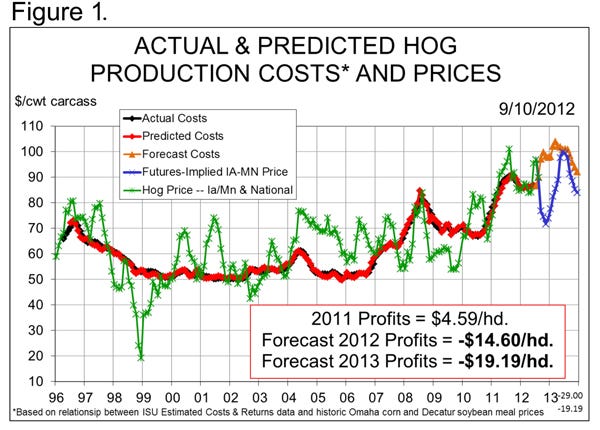Just the Facts: Ethanol Ate Our Lunch
I am a pretty black and white, “Just the facts, Ma’am” type of guy. Part of that is my nature and part of it is the fact that I stayed in school long enough that they gave me a fancy degree if I would just go away. That’s not completely accurate but may be closer than I want to admit.
September 10, 2012

I am a pretty black and white, “Just the facts, Ma’am” type of guy. Part of that is my nature and part of it is the fact that I stayed in school long enough that they gave me a fancy degree if I would just go away. That’s not completely accurate but may be closer than I want to admit.
The scientific method is, well, methodical. It forces investigators to identify problems, gather facts and synthesize explanations and implications, ideally without personal bias interjected into the proceedings. I hardly ever trust anyone who claims to be unbiased since we all have our biases about many, many things. At best, I believe I can only claim to try to be objective in the face of my biases and I will tell you what those biases are up-front as best I can. I’m not sure anyone can do much more than that.
All of this is offered to make the case that I can be a cold, hard facts person. Most of the time I can remove emotion from the equation. That is not always the case, but I think I’m reasonably good at taking objective views of matters in the “dismal science” of economics.
And then something like the letter I received last week comes along.
The profit situation for hog producers is dire, as all of you know all too well. CME Group futures for Lean Hogs (LH), Corn and Soybean Meal as of mid-morning on Monday, Sept.10, imply 2012 full-year losses averaging $14.60 per head and 2013 full-year losses averaging $19.19 per head. The 2012 figures include some losses this fall over $45/head. The 2013 figures include NO profitable months even with summer 2013 LH futures over $97.

Some think this situation will be the worst for big operations that buy all, or virtually all, of their feed. And there are some that may even think those companies (and/or family farms that have grown huge) might just deserve what they are getting. We need to be very careful about both.
The letter I got last week was from a small Missouri producer. He sent a copy of an article that was published last year that included a couple of quotes from me. I usually hate it when people start a comment with “Remember when you said . . .,” or, “I saw an article you wrote last year . . .” Very seldom are the next lines complimentary of my intelligence. It comes with the territory, I suppose.
This article was titled, “Livestock Producers Fear Ethanol Eating their Lunch by Gobbling up Too Much Corn.” The producer had circled or underlined several passages that addressed corn usage, the impact that a short crop might have, etc. Two circled passages were from me:
“If we get a short crop, the ethanol industry does not participate in rationing and the brunt will fall on livestock and poultry.”
“A 20% decline in the harvest would be enough to force corn rationing and lead to feed shortages. That would leave livestock farmers with little choice. We can’t shut down feeding. The only way to do that is to kill the animals.”
Let me first clarify a couple of things. First, the sentence should have said, “The ethanol industry cannot fully participate in rationing.” Make no mistake, the ethanol sector is cutting back, but it will do so only as far as the Renewable Fuel Standard (RFS) and the RINS (credits for past blending above the required levels) it has generated allow. Why not let the market decide that?
Second, “rationing” here was meant to imply that the market would work to spread available supplies over time, not that some government program would kick in to say who gets what. We will not run out of corn or soybeans as a country, but there will be places where shortages occur and life could be tough if you are in one of them.
And it has all come true this year. This producer wrote about selling his cattle and sows recently and seeing two other nearby farmers at the buying station on the day he shipped the sows. It’s not just the big guys getting hurt.
I have no idea how much education this producer has, but the real meaning of this situation did not escape him. He wrote: “Hamburger and sausage will be $10 a pound next year. Only the rich will be able to eat meat. I think ethanol already ate our lunch.”
And yet we are accused by the ethanol lobby of being opportunists who are using the drought as an excuse to tear down ethanol policy. I’m not sure how that can be true when most of us have said the same thing for years: Put all buyers of corn on an equal footing and let the market decide where corn will go. This year, that market would still put 4 billion-plus bushels of corn into ethanol. But the market would allow that usage to fall if oil and gasoline prices move lower. The RFS limits the extent of such a decrease even with RINS available.
My favorite from the e-lobby is this one, “The government shouldn’t be deciding winner and losers.” I believe it already has and my letter-writing friend from Missouri is one of the losers. Sadly, he has a lot of company. Many with limited means may join his ranks. Beans, anyone?


About the Author(s)
You May Also Like





